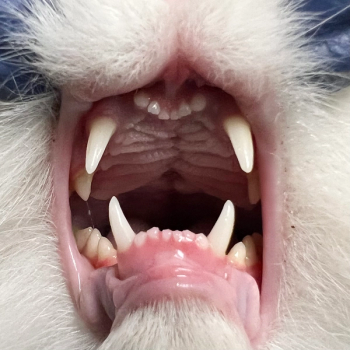
How to perform an ovariectomy
The ovariectomy technique is essentially the same in dogs and cats.
Step 1
Whether using a midline or flank approach, locate the first ovary through palpation or visualization. The feline ovary is usually more conspicuous than the canine. Sweeping the abdomen caudal to a kidney with a spay hook may allow you to snare the uterine horn. Visually identify the ovary, suspensory ligament, and tip of the uterus. In dogs, if the suspensory ligament is too short to allow adequate exteriorization of the ovarian structures, a fingertip may be used to stretch or tear the ligament.
Once the ovary is exteriorized, apply hemostatic forceps to the proper ligament to maintain traction. Alternatively, traction may be applied with a ring-shaped tissue-grasping forceps (pince en coeur) placed over the ovary.1 The latter option has the potential benefit of isolating the ovary from accidental incision. If the uterus is not adequately visualized, palpate it to the best extent possible through the incision for abnormalities that would preclude ovariectomy. In larger dogs, the caudal portion of the uterus may not be inspected without enlarging the incision. It is up to you whether such complete inspection is indicated.
Inspect the mesovarium for a thin relatively avascular area located caudal to the ovarian vascular plexus for fenestration. Cats may have more utero-ovarian venous anastomoses, which could complicate finding such a location. Once an appropriate site in the mesovarium is selected, fenestrate it and pass absorbable suture material through the fenestration (see figure above). The figure shows the medial aspect of an exteriorized left ovary in feline midline celiotomy. The left uterine horn (U) is to the right of the forceps. The ovary (O), visible through a thin portion of mesosalpinx, is retracted with forceps clamped to the proper ligament. A hemostat carrying suture has passed through the fenestration in the mesovarium. The ligature will then encompass the ovarian pedicle.
Step 2
Inspect the pedicle to ensure that the ligature will be placed adequately proximal to the mesosalpinx-enclosed ovary. Then tighten and securely knot the ligature around the ovarian pedicle, as seen in the figure. You may apply a second ligation for additional security, if needed. In mature animals with fatty mesenteries and large blood vessels, the ovarian pedicle may be carefully and bluntly divided into smaller pedicles for better ligature security.
Step 3
Next, pass a ligature through the window and allow it to encircle the tip of the uterine horn about 1 to 3 cm caudal to the proper ligament.2,3 Check it for proper placement, and then securely tighten and tie it (see figure above). Pass a second ligature, if needed.
The figure immediately above shows how the area will appear after the ligations for both the ovarian pedicle and the uterine pedicle are complete.
<
Step 4
Place two forceps across the ovarian pedicle between the ovary and the ligatures, and place two forceps across the proper ligament and uterine horn tip, as seen in the figure. Transect between each pair of forceps. Remove the excised portion, and check for complete ovarian removal. In dogs, the mesosalpinx usually must be incised to visualize the ovary. Release each remaining forceps while gently grasping the ligated structure and checking for adequate hemostasis. Treat the opposite ovary similarly. Before closing, examine the abdomen for hemorrhage.
REFERENCES
1. Bodin C. Réalisation d'un support audio-visuel à visée pédagogique des opérations de convenance de routine des femelles des carnivores domestiques (Production of an educational audio-visual aid on the routine elective operations of female domestic carnivores). Dissertation. École Nationale Vétérinaire de Nantes, 2008.
2. Rüsse M. Die ovariektomie der kätzin. (DVD) Der gynäkologischen und ambulatorischen. Tierklinik: München, Germany, 1982.
3. Kälin S, Meier S. Die kastration der kätzin. (DVD) Klinik für geburtshilfe und gynäkologie der vet.-med., Fakultät:Univeristät Zurich, TV Uni Zürich, 1987.
Newsletter
From exam room tips to practice management insights, get trusted veterinary news delivered straight to your inbox—subscribe to dvm360.






